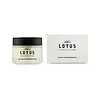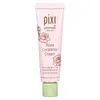What's inside
What's inside
 Key Ingredients
Key Ingredients

 Benefits
Benefits

 Concerns
Concerns

 Ingredients Side-by-side
Ingredients Side-by-side

Water
Skin ConditioningNelumbo Nucifera Leaf Extract
Skin ConditioningGlycerin
HumectantDipropylene Glycol
HumectantCetyl Ethylhexanoate
EmollientCaprylic/Capric Triglyceride
MaskingGlyceryl Stearate
EmollientCetearyl Alcohol
EmollientPentaerythrityl Tetraethylhexanoate
Emollient1,2-Hexanediol
Skin ConditioningBetaine
HumectantDimethicone
EmollientQuercus Acuta Branch/Leaf Extract
Skin ConditioningCyclopentasiloxane
EmollientBeeswax
Emulsion StabilisingSorbitan Stearate
EmulsifyingPEG-100 Stearate
Butylene Glycol
HumectantPolyacrylamide
Palmitic Acid
EmollientEthylhexylglycerin
Skin ConditioningCaprylyl Glycol
EmollientPolysilicone-11
Stearic Acid
CleansingC13-14 Isoparaffin
EmollientCarbomer
Emulsion StabilisingTromethamine
BufferingNylon-12
Silica
AbrasiveHippophae Rhamnoides Oil
EmollientAdenosine
Skin ConditioningLavandula Angustifolia Oil
MaskingCitrus Limon Peel Oil
MaskingLaureth-7
EmulsifyingDisodium EDTA
Ammonium Polyacryloyldimethyl Taurate
Emulsion StabilisingIsohexadecane
EmollientPolysorbate 40
EmulsifyingPEG-10 Dimethicone
Skin ConditioningCitrus Aurantifolia Oil
CleansingEucalyptus Globulus Leaf Oil
PerfumingRosmarinus Officinalis Leaf Oil
MaskingLauric Acid
CleansingMyristic Acid
CleansingCaramel
Cosmetic ColorantJuniperus Mexicana Oil
MaskingChamomilla Recutita Flower Oil
MaskingDextrin
AbsorbentPelargonium Graveolens Flower Oil
MaskingWater, Nelumbo Nucifera Leaf Extract, Glycerin, Dipropylene Glycol, Cetyl Ethylhexanoate, Caprylic/Capric Triglyceride, Glyceryl Stearate, Cetearyl Alcohol, Pentaerythrityl Tetraethylhexanoate, 1,2-Hexanediol, Betaine, Dimethicone, Quercus Acuta Branch/Leaf Extract, Cyclopentasiloxane, Beeswax, Sorbitan Stearate, PEG-100 Stearate, Butylene Glycol, Polyacrylamide, Palmitic Acid, Ethylhexylglycerin, Caprylyl Glycol, Polysilicone-11, Stearic Acid, C13-14 Isoparaffin, Carbomer, Tromethamine, Nylon-12, Silica, Hippophae Rhamnoides Oil, Adenosine, Lavandula Angustifolia Oil, Citrus Limon Peel Oil, Laureth-7, Disodium EDTA, Ammonium Polyacryloyldimethyl Taurate, Isohexadecane, Polysorbate 40, PEG-10 Dimethicone, Citrus Aurantifolia Oil, Eucalyptus Globulus Leaf Oil, Rosmarinus Officinalis Leaf Oil, Lauric Acid, Myristic Acid, Caramel, Juniperus Mexicana Oil, Chamomilla Recutita Flower Oil, Dextrin, Pelargonium Graveolens Flower Oil
Water
Skin ConditioningDipropylene Glycol
HumectantGlycerin
HumectantDimethicone
EmollientCaprylic/Capric Triglyceride
MaskingHydrogenated Poly(C6-14 Olefin)
EmollientHydrogenated Polydecene
EmollientCetearyl Alcohol
EmollientPEG-20 Methyl Glucose Sesquistearate
EmulsifyingBetaine
HumectantHydroxyethyl Acrylate/Sodium Acryloyldimethyl Taurate Copolymer
Emulsion StabilisingPolysilicone-11
1,2-Hexanediol
Skin ConditioningCyclopentasiloxane
EmollientGlyceryl Stearate
EmollientPEG-100 Stearate
Caprylyl Glycol
EmollientMethyl Glucose Sesquistearate
EmollientCitrus Paradisi Peel Oil
MaskingSorbitan Stearate
EmulsifyingButyrospermum Parkii Butter
Skin ConditioningOctyldodecanol
EmollientDimethiconol
EmollientButylene Glycol
HumectantBifida Ferment Lysate
Skin ConditioningCeramide NP
Skin ConditioningPolysorbate 60
EmulsifyingSorbitan Isostearate
EmulsifyingXanthan Gum
EmulsifyingCitrus Aurantium Bergamia Fruit Oil
MaskingHydrogenated Lecithin
EmulsifyingPortulaca Oleracea Extract
Skin ConditioningRosmarinus Officinalis Leaf Oil
MaskingPropanediol
SolventSucrose Cocoate
EmulsifyingDextrin
AbsorbentDisodium EDTA
Echium Plantagineum Seed Oil
Skin ConditioningCaramel
Cosmetic ColorantCentella Asiatica Extract
CleansingLecithin
EmollientPhenoxyethanol
PreservativeRosa Damascena Flower Oil
MaskingBiosaccharide Gum-1
HumectantCardiospermum Halicacabum Flower/Leaf/Vine Extract
Skin ConditioningHelianthus Annuus Seed Oil Unsaponifiables
EmollientPolyglutamic Acid
Skin ConditioningTagetes Minuta Flower Oil
MaskingPotassium Sorbate
PreservativeBetula Alba Bud Extract
Skin ConditioningCorylus Avellana Bud Extract
Skin ConditioningJuglans Regia Leaf Extract
AbrasiveOlea Europaea Bud Extract
AntioxidantTocopherol
AntioxidantWater, Dipropylene Glycol, Glycerin, Dimethicone, Caprylic/Capric Triglyceride, Hydrogenated Poly(C6-14 Olefin), Hydrogenated Polydecene, Cetearyl Alcohol, PEG-20 Methyl Glucose Sesquistearate, Betaine, Hydroxyethyl Acrylate/Sodium Acryloyldimethyl Taurate Copolymer, Polysilicone-11, 1,2-Hexanediol, Cyclopentasiloxane, Glyceryl Stearate, PEG-100 Stearate, Caprylyl Glycol, Methyl Glucose Sesquistearate, Citrus Paradisi Peel Oil, Sorbitan Stearate, Butyrospermum Parkii Butter, Octyldodecanol, Dimethiconol, Butylene Glycol, Bifida Ferment Lysate, Ceramide NP, Polysorbate 60, Sorbitan Isostearate, Xanthan Gum, Citrus Aurantium Bergamia Fruit Oil, Hydrogenated Lecithin, Portulaca Oleracea Extract, Rosmarinus Officinalis Leaf Oil, Propanediol, Sucrose Cocoate, Dextrin, Disodium EDTA, Echium Plantagineum Seed Oil, Caramel, Centella Asiatica Extract, Lecithin, Phenoxyethanol, Rosa Damascena Flower Oil, Biosaccharide Gum-1, Cardiospermum Halicacabum Flower/Leaf/Vine Extract, Helianthus Annuus Seed Oil Unsaponifiables, Polyglutamic Acid, Tagetes Minuta Flower Oil, Potassium Sorbate, Betula Alba Bud Extract, Corylus Avellana Bud Extract, Juglans Regia Leaf Extract, Olea Europaea Bud Extract, Tocopherol
Ingredients Explained
These ingredients are found in both products.
Ingredients higher up in an ingredient list are typically present in a larger amount.
1,2-Hexanediol is a synthetic liquid and another multi-functional powerhouse.
It is a:
- Humectant, drawing moisture into the skin
- Emollient, helping to soften skin
- Solvent, dispersing and stabilizing formulas
- Preservative booster, enhancing the antimicrobial activity of other preservatives
Betaine is a common humectant (a substance that promotes retention of moisture). It's known to be gentle on the skin and can help balance hydration.
This ingredient is best for improving hydration and soothing irritated skin. Studies also show it helps even out skin tone.
Fun fact: Betaine is naturally created in the skin and body. The kind found within cosmetic products can be either plant-derived or synthetic.
Another name for betaine is trimethylglycine.
Learn more about BetaineButylene Glycol (or BG) is used within cosmetic products for a few different reasons:
Overall, Butylene Glycol is a safe and well-rounded ingredient that works well with other ingredients.
Though this ingredient works well with most skin types, some people with sensitive skin may experience a reaction such as allergic rashes, closed comedones, or itchiness.
Learn more about Butylene GlycolThis ingredient is an emollient, solvent, and texture enhancer. It is considered a skin-softener by helping the skin prevent moisture loss.
It helps thicken a product's formula and makes it easier to spread by dissolving clumping compounds.
Caprylic Triglyceride is made by combining glycerin with coconut oil, forming a clear liquid.
While there is an assumption Caprylic Triglyceride can clog pores due to it being derived from coconut oil, there is no research supporting this.
Learn more about Caprylic/Capric TriglycerideCaprylyl Glycol is a humectant and emollient, meaning it attracts and preserves moisture.
It is a common ingredient in many products, especially those designed to hydrate skin. The primary benefits are retaining moisture, skin softening, and promoting a healthy skin barrier.
Though Caprylyl Glycol is an alcohol derived from fatty acids, it is not the kind that can dry out skin.
This ingredient is also used as a preservative to extend the life of products. It has slight antimicrobial properties.
Learn more about Caprylyl GlycolWe don't have a description for Caramel yet.
Cetearyl alcohol is a mixture of two fatty alcohols: cetyl alcohol and stearyl alcohol. It is mainly used as an emulsifier. Emulsifiers help prevent the separation of oils and products. Due to its composition, it can also be used to thicken a product or help create foam.
Cetearyl alcohol is an emollient. Emollients help soothe and hydrate the skin by trapping moisture.
Studies show Cetearyl alcohol is non-toxic and non-irritating. The FDA allows products labeled "alcohol-free" to have fatty alcohols.
This ingredient is usually derived from plant oils such as palm, vegetable, or coconut oils. There is debate on whether this ingredient will cause acne.
Due to the fatty acid base, this ingredient may not be Malassezia folliculitis safe.
Learn more about Cetearyl AlcoholCyclopentasiloxane, or D5, is a silicone used to improve texture of products and trap moisture.
D5 is considered lightweight and volatile. Volatile means it evaporates quickly after application. Once evaporated, D5 leaves a thin barrier that helps keep skin hydrated.
It is also an emollient. Emollients help soften the skin and prevent water loss. Silicones create a silky texture in products. D5 helps other ingredients become more spreadable.
Studies show D5 is safe to use in skincare products. We recommend speaking with a skincare professional if you have concerns.
Learn more about CyclopentasiloxaneDextrin is used to thicken a product and helps bind ingredients together. It is created from starch and glycogen.
As an emulsifier, dextrin prevents ingredients from separating. This helps elongate a product's shelf life.
Studies show coating UV filters with dextrin prevents these ingredients from being absorbed. This helps UV ingredients last longer on the skin.
Learn more about DextrinDimethicone is a type of synthetic silicone created from natural materials such as quartz.
What it does:
Dimethicone comes in different viscosities:
Depending on the viscosity, dimethicone has different properties.
Ingredients lists don't always show which type is used, so we recommend reaching out to the brand if you have questions about the viscosity.
This ingredient is unlikely to cause irritation because it does not get absorbed into skin. However, people with silicone allergies should be careful about using this ingredient.
Note: Dimethicone may contribute to pilling. This is because it is not oil or water soluble, so pilling may occur when layered with products. When mixed with heavy oils in a formula, the outcome is also quite greasy.
Learn more about DimethiconeDipropylene Glycol is a synthetically created humectant, stabilizer, and solvent.
This ingredient helps:
Dipropylene glycol is technically an alcohol, but it belongs to the glycol family (often considered part of the ‘good’ alcohols). This means it is hydrating and gentle on skin unlike drying solvent alcohols like denatured alcohol.
As a masking agent, Dipropylene Glycol can be used to cover the smell of other ingredients. However, it does not have a scent.
Studies show Dipropylene Glycol is considered safe to use in skincare.
Learn more about Dipropylene GlycolDisodium EDTA plays a role in making products more stable by aiding other preservatives.
It is a chelating agent, meaning it neutralizes metal ions that may be found in a product.
Disodium EDTA is a salt of edetic acid and is found to be safe in cosmetic ingredients.
Learn more about Disodium EDTAGlycerin is already naturally found in your skin. It helps moisturize and protect your skin.
A study from 2016 found glycerin to be more effective as a humectant than AHAs and hyaluronic acid.
As a humectant, it helps the skin stay hydrated by pulling moisture to your skin. The low molecular weight of glycerin allows it to pull moisture into the deeper layers of your skin.
Hydrated skin improves your skin barrier; Your skin barrier helps protect against irritants and bacteria.
Glycerin has also been found to have antimicrobial and antiviral properties. Due to these properties, glycerin is often used in wound and burn treatments.
In cosmetics, glycerin is usually derived from plants such as soybean or palm. However, it can also be sourced from animals, such as tallow or animal fat.
This ingredient is organic, colorless, odorless, and non-toxic.
Glycerin is the name for this ingredient in American English. British English uses Glycerol/Glycerine.
Learn more about GlycerinGlyceryl Stearate is a mix of glycerin and stearic acid.
It is used to stabilize the mixing of water and oil ingredients. By preventing these ingredients from separating, it can help elongate shelf life. It can also help thicken the product's texture.
As an emollient, it helps soften skin and supports barrier-replenishing ingredients.
In cosmetics, Glyceryl Stearate is often made from vegetable oils or synthetically produced.
This ingredient may not be fungal-acne safe
Fun fact: The human body also creates Glyceryl Stearate naturally.
Learn more about Glyceryl StearatePeg-100 Stearate is an emollient and emulsifier. As an emollient, it helps keep skin soft by trapping moisture in. On the other hand, emulsifiers help prevent oil and water from separating in a product.
PEGS are a hydrophilic polyether compound . There are 100 ethylene oxide monomers in Peg-100 Stearate. Peg-100 Stearate is polyethylene glycol ester of stearic acid.
Polysilicone-11 is a film-forming silicone that creates a non-tacky and matte finish on the skin. It's commonly used to improve texture, absorb excess oil, and help active ingredients spread evenly.
Due to its "rubber-like" structure, it stays on the skin's surface instead of being absorbed. On the skin, it creates a flexible layer that enhances wearability and stability.
Rosmarinus Officinalis Leaf Oil is oil expressed from the leaves of the rosemary plant.
Rosemary Leaf Oil is a fragrance and helps give your product a scent. If you are sensitive to irritating fragrances, this one contains camphor. Camphor has been found to irritate skin.
This oil also contains antioxidant and antimicrobial properties. As an antioxidant, it may protect you skin against damage. This can help slow down the signs of aging.
Learn more about Rosmarinus Officinalis Leaf OilSorbitan Stearate comes from sorbitol and stearic acid. Sorbitol is a type of sugar and stearic acid is a fatty acid.
It is used as an emulsifier and helps ingredients stay together by creating water-in-oil emulsions.
This ingredient may not be Malassezia folliculitis, or fungal-acne safe.
Water. It's the most common cosmetic ingredient of all. You'll usually see it at the top of ingredient lists, meaning that it makes up the largest part of the product.
So why is it so popular? Water most often acts as a solvent - this means that it helps dissolve other ingredients into the formulation.
You'll also recognize water as that liquid we all need to stay alive. If you see this, drink a glass of water. Stay hydrated!
Learn more about Water